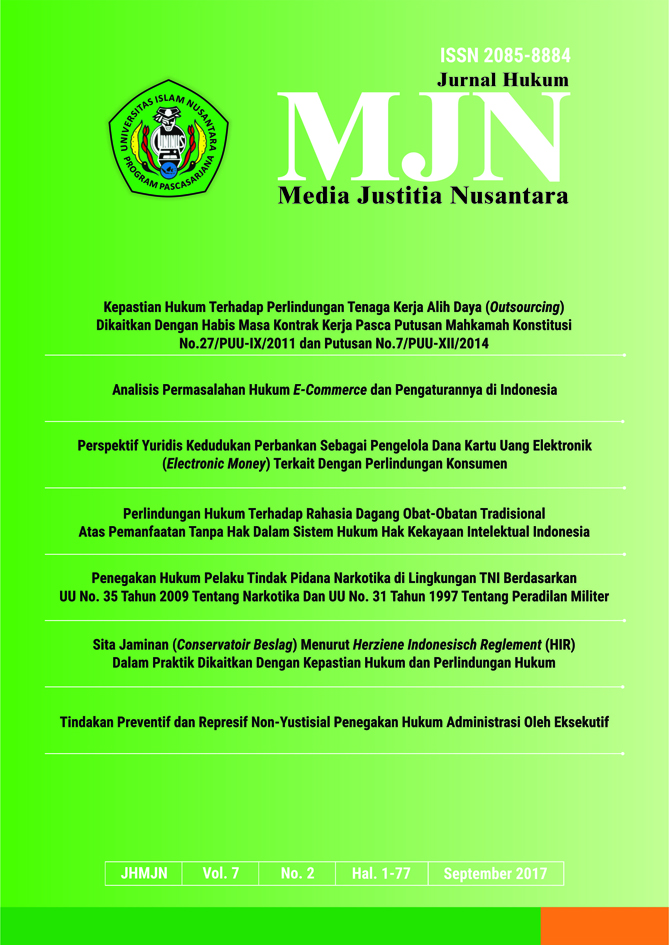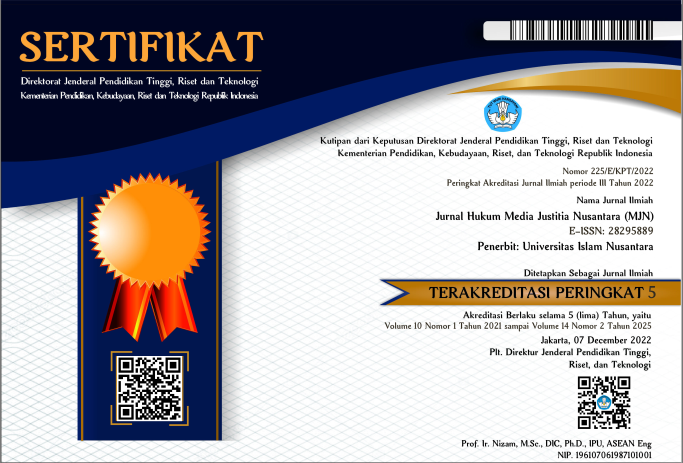Serious crimes and capital punishment in the history of criminal law are two components of closely related issues. This is apparent in the Indonesian Criminal Code which threatens serious crimes with capital punishment. Implementation of capital punishment reap the pros and cons this is motivated by various reasons. Plot murder accompanied by mutilation is a motive for murder committed sadistic and cruel, the motive is done to eliminate traces of deeds that have been done. Planning murder coupled with mutilation as an aggravating factor may be subject to a death sentence, this is because in murder it is not a qualified offense as the basis of ballast. The problem identification in the writing of this thesis involves: how is the existence of capital punishment for the crime of premeditated murder and how the criminal law enforcement related to capital punishment to murder murder is accompanied by mutilation as a burden. The research method used in this compiler is by using the normative juridical method while the specification of writing in this thesis is descriptive analysis, the research stage in this study is primary data obtained from field research and secondary data in the form of primary legal materials, secondary law materials and tertiary legal materials. Based on the description and analysis of the problem it is known that the existence or existence of capital punishment for the crime of premeditated murder is still maintained and valid until now in Indonesia, as it has been in accordance with the provisions of Article 340 of the Criminal Code. The existence of capital punishment as one of the criminal types that is still recognized in the Criminal Law System in Indonesia, is often associated with absolute theory in criminal prosecution. Criminal acts committed by perpetrators are considered very evil, because it interferes with public security, threatens the safety of the people, and is seen as an extraordinary crime (extra ordinary crime). In relation to the crime of premeditated murder as mentioned in Article 581 of the Criminal Code Bill, it also includes a capital punishment, but it can be threatened alternatively with other criminal types, such as life imprisonment or imprisonment of a minimum of five years and a maximum of 20 years. In this case, the draft of the Criminal Code does not specify mutilations specifically as a criminal offense, but if viewed from the provisions of Article 55 paragraph (1) of the Criminal Code Bill, then mutilation may constitute a motive and purpose of committing a crime (letter b); how to commit a crime; as well as the attitude and actions of the producers after committing a crime. As for the suggestion to be conveyed is the government must still maintain the threat of capital punishment by making the rules clearly and firmly against the perpetrators of criminal acts of premeditated murder. The need of the Indonesian Criminal Code is urgent, the government is reasonable, to immediately enact it, so that the provisions contained in Article 55 of the Criminal Code Draft can be used as a guideline for the judge in the imposition of criminal verdict against murder murder with mutilation as incriminating, law, namely the creation of legal certainty, legal benefit, and legal justice.
17-10-2019
Priyono, P. (2019). Eksistensi Pidana Mati Dalam Persfektif KUHP (Studi Kasus Pembunuhan Berencana Disertai Mutilasi Korban Berdasarkan Putusan Mahkamah Agung No. 25 PK/PID/2012). JURNAL HUKUM MEDIA JUSTITIA NUSANTARA, 8(1), 10–22. https://doi.org/10.30999/mjn.v8i1.662
Article
Similar Articles
- Jajang Sultonudin, Perlindungan Hukum Terhadap Warga Binaan Dalam Memperoleh Hak Atas Pemenuhan Makanan Yang Layak Dikaitkan Dengan Pengelolaan Keuangan (Studi Pada Lembaga Pemasyarakatan Kelas IIA Cikarang) , JURNAL HUKUM MEDIA JUSTITIA NUSANTARA: Vol. 11 No. 1 (2021): Februari 2021
- Indra Ganjar Nugraha, Analisis Penerapan Sanksi Terhadap Pegawai Negeri Sipil Terkait Dengan Penggelapan Barang Persediaan Milik Negara Berdasarkan Hukum Penyelenggaraan Negara (Studi Kasus di Rumah Tahanan Negara Klas I Bandung) , JURNAL HUKUM MEDIA JUSTITIA NUSANTARA: Vol. 8 No. 2 (2018): September 2018
- Susi Bina Kurniati, Tinjauan Yuridis Terhadap Penetapan Tersangka Dalam Perkara Gugatan Praperadilan Pasca Putusan Mahkamah Konstitusi Nomor 21/PUU/XII/2014 Dihubungkan Dengan Peran Advokat Bidkum Polda Jabar , JURNAL HUKUM MEDIA JUSTITIA NUSANTARA: Vol. 11 No. 2 (2021): September 2021
- Rulli Nanda, Kajian Yuridis Terhadap Pembuktian Tindak Pidana Pencurian Data Pribadi Melalui Internet Dihubungkan Dengan Undang-Undang Nomor 19 Tahun 2016 Tentang Informasi dan Transaksi Elektronik , JURNAL HUKUM MEDIA JUSTITIA NUSANTARA: Vol. 10 No. 2 (2020): September 2020
- Mita Wulan Ndari, Arikha Saputra, TINJAUAN YURIDIS PERLINDUNGAN HUKUM TERHADAP DATA KONSUMEN PENGGUNA APLIKASI PINJAMAN ONLINE LEGAL (STUDI KASUS PADA APLIKASI PINJAMAN ONLINE ADAKAMI) , JURNAL HUKUM MEDIA JUSTITIA NUSANTARA: Vol. 13 No. 2 (2023): September 2023
- Wahyu Daeni, Perlindungan Hukum Bagi Penyidik Polri Dalam Melaksanakan Tugas dan Fungsinya Guna Terwujud Tegaknya Hukum dan Ketertiban Dalam Perspektif Hak Azasi Manusia , JURNAL HUKUM MEDIA JUSTITIA NUSANTARA: Vol. 8 No. 1 (2018): Februari 2018
- Amung Ma’mur, Dadin Solihin, Potret Good Government Dewan Perwakilan Rakyat Daerah Kabupaten Bandung Barat , JURNAL HUKUM MEDIA JUSTITIA NUSANTARA: Vol. 11 No. 2 (2021): September 2021
- Lina Rodiah, Perbuatan Melawan Hukum Dalam Perjanjian Pemberian Kredit Dan Pembebanan Hak Tanggungan Tanpa Persetujuan Pasangan Perkawinan Dalam Perspektif Hukum Harta Benda Dalam Perkawinan , JURNAL HUKUM MEDIA JUSTITIA NUSANTARA: Vol. 11 No. 1 (2021): Februari 2021
- Daniel Romi Sihombing, Perlindungan Hukum Bagi Debitur Wanprestasi Dalam Eksekusi Jaminan Fidusia Berdasarkan Undang-Undang Nomor 42 Tahun 1999 Tentang Fidusia , JURNAL HUKUM MEDIA JUSTITIA NUSANTARA: Vol. 6 No. 1 (2016): Februari 2016
- Achmad Gunawan, Kajian Yuridis Tentang Penggantian Antar Waktu Pimpinan Dan Anggota Dewan Perwakilan Rakyat Daerah Hubungannya Dengan Kepastian Hukum Dalam Negara Kesejahteraan , JURNAL HUKUM MEDIA JUSTITIA NUSANTARA: Vol. 9 No. 1 (2019): Februari 2019
<< < 1 2 3 4 5 6 7 8 9 10 > >>
You may also start an advanced similarity search for this article.













